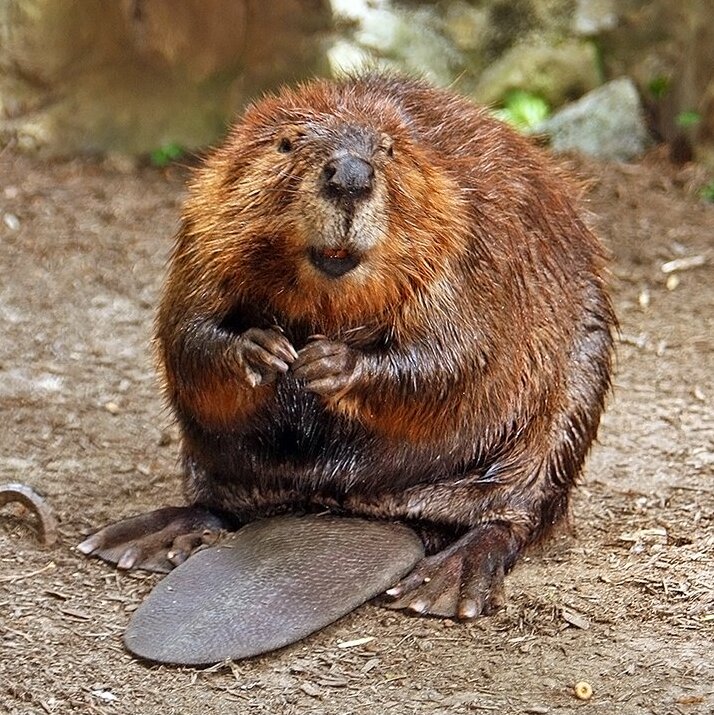Facts for Kids
Beavers are large, semi-aquatic rodents known for their distinctive flat tails and remarkable ability to build dams and lodges, significantly influencing their habitats.
Overview
Conservation Status
Cultural Significance
Ecological Importance
Diet And Feeding Habits
Habitat And Distribution
Physical Characteristics
Reproduction And Life Cycle
Behavior And Social Structure

Inside this Article
Climate Change
United States
Coat Of Arms
Swimming
Capybara
Building
Nature
Energy
Adult
Did you know?
🦫 Beavers are the second-largest rodents in the world, with adult weights of 40 to 60 pounds.
🏞️ They are known for their incredible building skills, creating dams and lodges from wood, mud, and stones.
🌍 Beavers play a crucial role in their ecosystems by creating wetlands that support diverse wildlife.
🌳 Their front teeth grow continuously, allowing them to gnaw on trees and branches without wearing them down.
🔊 Beavers communicate using a variety of sounds, including whistles, grunts, and tail slaps on the water.
💧 A beaver can hold its breath underwater for up to 15 minutes while swimming.
🍂 Beavers are herbivores, primarily feeding on the bark, leaves, and twigs of trees and shrubs.
🏡 They typically build their dams in flowing water, creating ponds that help protect them from predators.
🌙 Beavers are primarily nocturnal, doing most of their feeding and construction work at night.
🛠️ Beavers have powerful jaws and sharp incisors that can fell large trees to gather building materials.
Introduction
They are the second largest rodents in the world, after the capybara, and can weigh between 35 to 65 pounds (16 to 30 kg). Found in North America, Europe, and parts of Asia, they love to live near lakes, rivers, and streams. Beavers are famous for their dam-building, which they construct using branches, mud, and stones. This not only creates safe habitats for themselves but also helps to create new ecosystems for other animals! 🏞
️ Their scientific name is Castor, and they have two main types: the North American beaver and the Eurasian beaver.
Conservation Status
This caused a decline in their population, but thanks to conservation efforts, beavers are now recovering! They are classified as "Least Concern" by the IUCN, meaning they are not currently at risk of extinction. However, their habitats can still be threatened by pollution, habitat loss, and climate change. 🌎
Many organizations work to protect beaver populations and educate people about their importance in the ecosystem. Conservation is essential for keeping these industrious mammals thriving!
Cultural Significance
In Native American folklore, beavers are seen as symbols of hard work and teamwork. Many tribes tell stories about their building skills and how they create homes for other animals. In Canada, the beaver is a national symbol, featured on the 5-cent coin and even in the country's coat of arms! 🍁
Additionally, beavers have inspired art, literature, and even movies. Their unique lifestyle and strong character make them beloved in various cultures around the world! 🎨
Ecological Importance
️ Their dams create ponds that can help regulate water flow, prevent flooding, and create new habitats for other animals like fish, frogs, and birds. 🌈
These ponds also filter pollutants and provide a home for diverse plant species. By digging canals, beavers allow water to reach new areas, supporting ecosystems. Their activities contribute to a healthy environment, making them a keystone species, meaning their presence is crucial for the survival of many other species. They truly play a vital role in keeping nature in balance!
Diet And Feeding Habits
Their favorite foods include the bark of trees, leaves, and aquatic plants. They eat a lot to gain energy for their busy lives. During the winter, when food is scarce, beavers store branches underwater to snack on later. 🍂
Their powerful teeth allow them to gnaw through tree trunks, making it easier to access tasty bark. Beavers are skilled foragers, and they can adapt their diet based on the season and what's available in their habitat.
Habitat And Distribution
You can find the North American beaver in Canada, the United States, and Mexico, while the Eurasian beaver lives in countries like Germany and Russia. They prefer places with plenty of trees, such as aspens and poplars, because these provide food and building materials. Beavers are expert builders, creating dams to form ponds that can be over a mile long! 🌳
These ponds serve as their homes and create a safe space for other wildlife.
Physical Characteristics
Their front teeth, called incisors, are sharp and continuously grow, perfect for gnawing wood! Their bodies are sturdy and they have large, flat tails that help them balance and swim. 🏊
♂️ Beavers can grow to be around 3 to 4 feet long, including their tail. They have webbed feet for swimming and small ears and eyes that help them see while partially submerged. Their teeth are orange due to the iron in their diet, which helps them stay strong!
Reproduction And Life Cycle
They mate for life, which means they partner with one another for a long time. After a gestation period of about 3 months, the female beaver gives birth to a litter of 2 to 4 kits, usually in spring. 🐿
️ The kits are born blind and helpless, but they grow quickly! They stay with their parents for about a year, learning vital survival skills. After leaving home, some young beavers may help their parents in building dams before starting their families! In the wild, beavers can live up to 10 years.
Behavior And Social Structure
They are mostly nocturnal, meaning they are most active at night when they gather food and maintain their homes. Their strong bonds help keep the family safe and organized.

